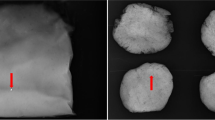Abstract
Bullet-derived lead in game food products is an important source of human contamination. Careless removal of tissues from around the bullet pathway in the animal body results in elevated lead doses being ingested by humans. To assess bullet-derived lead contamination of soft game tissues, muscle tissue samples were collected from ten wild boars and ten red deer immediately after they had been shot. The samples were collected from around the entry and exit wounds, from around the bullet pathway at different sites along its length, and from a distance of about 5, 15, 25, and 30 cm from the bullet track. The individuals examined differed in the lead contents in their tissues surrounding the entry and exit wounds and at different sites along the bullet pathway. One of the animals showed as much lead as 1,095.9 mg kg−1 wet weight in the tissue surrounding the bullet track near the entry wound, 736.0 mg kg−1 being recorded around the exit wound.

Similar content being viewed by others
References
Baranowski H (1993a) Działanie rażące pocisków kulowych. [Killing efficiency of bullet-type projectiles]. Łow Pol 7:26–27 [in Polish]
Baranowski H (1993b) Głębokość penetracji pocisków grzybkujących. [Penetration depth of mushrooming bullets]. Łow Pol 8:22–23 [in Polish]
Baranowski H (1993c) Jak przebiega penetracja pocisku półpłaszczowego. ? [How does a half-jacketed bullet penetrate?]. Łow Pol 9:26–27 [in Polish]
Clark AJ, Scheuhammer AM (2003) Lead poisoning in upland-foraging birds of prey in Canada. Ecotoxicology 12(1–4):23–30
Commission Regulation (EC) (2001) No. 466/2001 of March 2001. Official Journal of the European Communities
Custer TW, Hofman WL (1994) Trace elements in canvasbacks (Aythia valisneria) Wintering in Louisiana USA 1987–1988. Environ Pollut 84:253–259
Dobrowolska A, Melosik M (2002) Ołów postrzałowy jako źródło skażenia dziczyzny. . Shot-derived lead—a source of contamination in game animals. Folia Univ Agric Stetin Zootech 227(44):41–44
Elvestad K, Karlog O, Clausen B (1982) Heavy metals (copper, cadmium, lead, mercury) in mute swans from Denmark. Nord Vet Med 34:92–97
European Commission Enterprise Directorate-General (2004) Advantages and drawbacks of restricting the marketing and use of lead in ammunition, fishing sinkers and candle wicks. Final Report, pp 1–216
Floriańczyk B (1997) Toksyczne właściwości ołowiu. [Toxic properties of lead]. Probl Lek 3:169–176 [in Polish]
Fry DM (2003) Assessment of lead contamination sources exposing California Condors. Species Conservation and Recovery Program Report 2003-02
Guitart R, Serratosa J, Thomas VG (2002) Lead-poisoned wildfowl in Spain: a significant threat for human consumers. Int J Environ Health Res 12(4):301–309
Heinz GH, Hoffman DJ, Sileo L, Audet DJ, LeCaptain LJ (1999) Toxicity of lead-contaminated sediment to mallards. Arch Environ Cont Toxicol 36:323–333
Johansen P, Asmund G, Rigest F (2004) High human exposure to lead through consumption of birds hunted with lead shot. Environ Pollut 127(1):125–129
Kock M, Kosmus W, Pichler-Semmelrock FP, Sixl W (1989) Accumulation of heavy metals in animals. Part 1: Lead and cadmium contamination in some wild animals. J Hyg Epidemiol Microbiol Immunol 33(4 Suppl):521–528
Kramarova M, Massanyi P, Slamecka J, Tataruch F, Jancova A, Gasparik J, Fabis M, Kovacik J, Toman R, Galova J, Jurcik R (2005) Distribution of cadmium and lead in liver and kidney of some wild animals in Slovakia. J Environ Sci Health Part A Environ Sci Eng Toxic Hazard Subst 40(3):593–600
Lazarus M, Vickovic I, Sostaric B, Blanusa M (2005) Heavy metal levels in tissues of red deer (Cervus elaphus) from eastern Croatia. Arh Hig Rada Toksikol 56:233–240
Levengood JM (2003) Cadmium and lead in tissues of Mallards (Anas platyrhynchos) and wood ducts (Aix sponsa) using the Illions River (USA). Environ Pollut 122(2):177–181
Meissner W (1993) Ołów–powolna śmierć. [Lead, the slow death]. Łow Pol 4:21 [in Polish]
Monkiewicz J, Jaczewski S (1990) Rozmieszczenie ołowiu w tuszy dzików w zależności od odległości od rany postrzałowej. [Lead distribution in wild boar carcass in relation to the distance away from the shot wound]. Med Wet 46:187–188 [in Polish]
Norman FI, Garnham JS, Lowe KW (1993) Further notes on lead concentrations in tissue of waterfowl in Wictoria. Wild Res 20:621–624
Piskorova L, Vasilkova Z, Krupicer I (2003) Heavy metal residues in tissues of Wild boar (Sus scrofa) and red fox (Vulpes vulpes) in the Central Zemplin region of the Slovak Republic Czech. J Anim Sci 48(3):134–138
Pokorny B (2000) Roe deer Capreolus capreolus as an accumulative bioindicator of heavy metals in Slovenia. Web Ecology 1:54–62
Potts GR (2005) Incidence of ingested lead gunshot in wild grey partridges (Perdix perdix) from the UK. Eur J Wildl Res 51:31–34
Santiago D, Motas-Guzman M, Reja A, Maria-Mojica P, Rodero B, Garcia Fernandez AJ (1998) Lead and cadmium in deer and wild boar from Sierra Morena Mountains (Andalusia, Spain). Bull Contam Toxicol 61:730–737
Scheuhammer AM (1989) Monitoring wild bird pollutions for lead exposure. J Wildl Manage 53(3):759–765
Scheuhammer AM (1991) Effects of acidification on the availability of toxic metals and calcium to wild birds and mammals. Environ Pollut 71:329–375
Szkoda J, Żmudzki J (2005) Determination of lead and cadmium in biological material by graphite furnace atomic absorption spectrometry method. Bull Vet Inst Pulawy 49:89–92
Wickson RJ, Norman FI, Bacher GJ, Garnham JS (1992) Concentrations of lead in bone and other tissues of Wiktorian Waterfowl. Wild Res 19:221–232
Wolkers H, Wensing T, Groot Bruinderink GW (1994) Heavy metal contamination in organs of red deer (Cervus elaphus) and wild boar (Sus scrofa) and the effect on some trace elements. Sci Total Environ 144(1–3):191–199
Żmudzki J (1977) Oznaczenie zawartości ołowiu w materiale biologicznym metodą spektrofotometrii atomowo-absorpcyjnej. [Lead assays in biological materials with atomic absorption spectrophotometry]. Med Wet 3:179–181 [in Polish]
Acknowledgements
We are grateful to two anonymous reviewers whose comments helped to improve the manuscript.
Author information
Authors and Affiliations
Corresponding author
Additional information
Communicated by H. Kierdorf
Rights and permissions
About this article
Cite this article
Dobrowolska, A., Melosik, M. Bullet-derived lead in tissues of the wild boar (Sus scrofa) and red deer (Cervus elaphus). Eur J Wildl Res 54, 231–235 (2008). https://doi.org/10.1007/s10344-007-0134-y
Received:
Revised:
Accepted:
Published:
Issue Date:
DOI: https://doi.org/10.1007/s10344-007-0134-y




